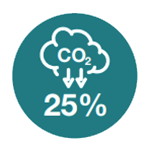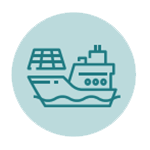WP3 Future ship technologies
Key Findings
KF3.1
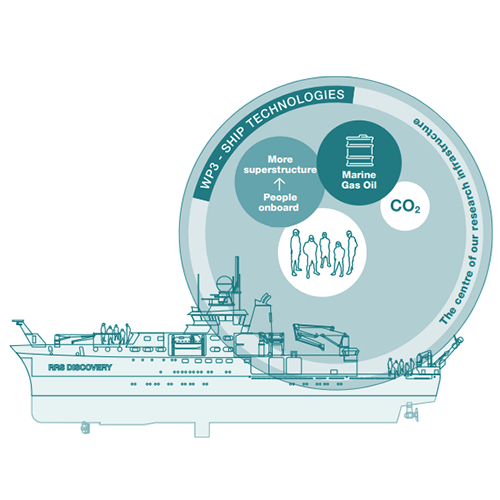
There are opportunities to reduce the CO2e footprint of the current vessels across a range of Energy Efficiency Measures (EEMs) which could reduce CO2e emissions by up to 25%. These include: route optimisation, hull form optimisation, wind assistance technologies, advanced hull coatings, speed reduction, main engine improvements, auxiliary systems improvements as well as modification to allow ships to ‘plug in’ to green shore electrical supplies and even sustainable food policies. In the medium term (5–10 years) consideration might be given to using lower-carbon ICE fuels, e.g., biodiesel, if their cost, availability and quality permits.
KF3.2
Nuclear and non-fuel based alternative energy options are attractive from a carbon emissions perspective and are seeing a resurgence in Research and Development (R&D). However, nuclear power, e.g., Small Modular Reactors (SMRs), still faces a range of regulatory, public perception and political challenges, and is currently very high cost. Wind and solar are limited to being considered as useful EEMs as they can’t meet all of the propulsive and energy requirements of a research ship, its complex operating profile and dynamic positioning requirements.
KF3.3
Alongside these technological innovations, a coordinated, international system of bartering (modelled on the Oceans Facilities Exchange Group system) presents an opportunity to significantly reduce passage legs but will take time and concerted effort to achieve. This option may require some vessels to be semi-permanently based away from their home countries to ensure even coverage given the limited availability of research vessels outside of Europe, North America and China/Japan/South Korea/Australia/New Zealand. The challenges to setting up and sustaining this should not be underestimated and the UK should focus on better co-ordinating its national assets as a priority.
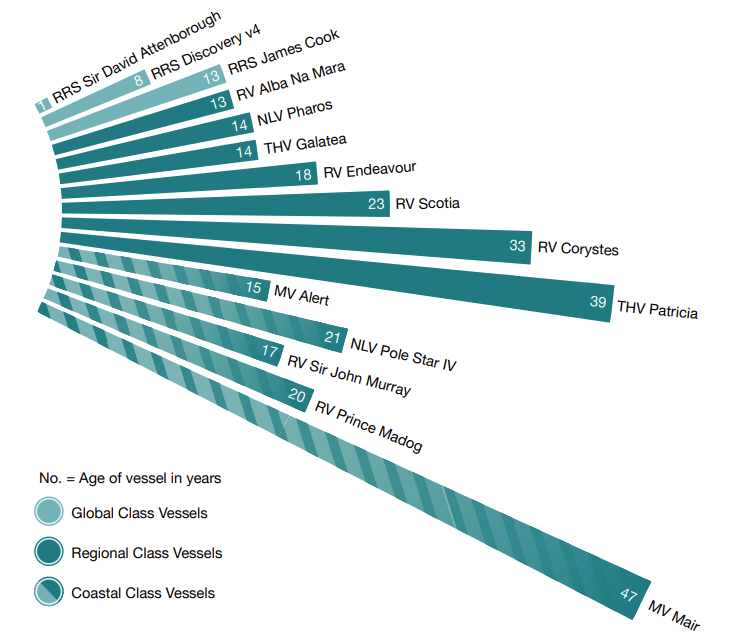
KF3.4
The data collected from research vessels should be maximised at all times to justify the CO2e footprint. Bathymetry, underway sampling and meteorological sampling should be collected at all times. This is quick and easy to implement but requires funding to enable data processing, storage and use.
KF3.5
In addition, telepresence and high-speed data transfer should be considered the norm and allow shore-based science parties to interact with ship-based scientists and technicians.
KF3.6
When considering the UK mix of polar, global, regional and coastal research and monitoring vessels as well as the Royal Navy’s Multi-Role Oceanographic Survey Ship it is apparent that there is potential for a UK shipbuilding programme that could enable inter-operability, reduce risks and therefore costs by using common/modular design techniques and deliver a world-leading oceanographic survey fleet capable of supporting UK development of zero-carbon fuel systems, enhanced autonomy and increased inter-connectivity with MAS platforms. This would support the UK’s Maritime 2050 strategy.
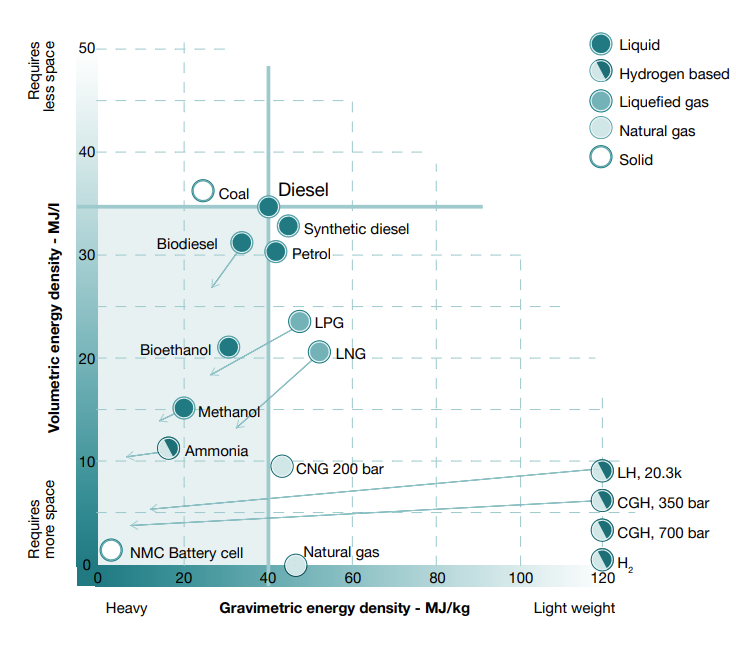
KF3.7
Future global-class research vessels will probably use an ammonia/fuel cell or H2/fuel cell combination. These options will fundamentally alter the design of the vessel as they are less power dense. To avoid increasing the size of vessels, the proposed solution is to reduce the space required for personnel and capability, specifically that capability that can be delivered by MAS platforms. This will require the current trend in automation of ship navigation, pilotage and general operations as well as operations specific to research vessels, e.g., over-boarding systems and winches, to be accelerated and proven.
KF3.8
Identify opportunities to invest in the latest ‘green ship’ technology and be prepared to trial this on smaller, coastal class vessels. Partnerships with industrial partners could make this more affordable, particularly with respect to fuel technology where investment in the supporting logistical systems will be necessary. NERC could leverage its entire fleet to mitigate the risks associated with this.
Key Recommendations
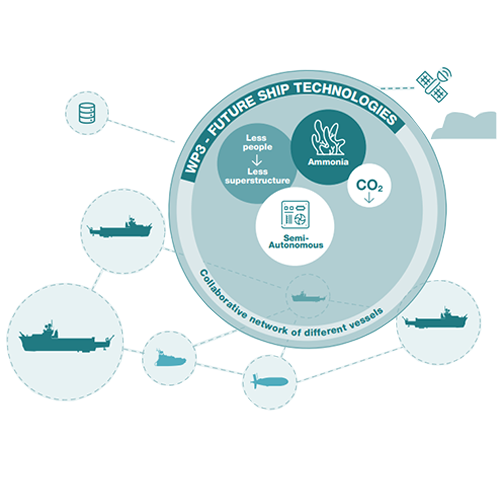
KR3.1
The prioritisation criteria for bids for NERC ship-time should be reviewed so that ‘sustainable planning’ across the Marine Facilities Planning (MFP) becomes a key aim. In support of this:
- Continue to invest heavily in supporting the OFEG bartering scheme and seek to replicate wherever possible, particularly across the UK research fleet.
- Consider ‘campaigns’ that place a research ship in one part of the ocean for an extended period.
- Shift the refit timings of at least one of the two blue-water research vessels so that use of the ship during the summer period (normally calmer weather) around the UK can be maximised.
KR3.2
NERC’s research ships should be modified to allow them to take advantage of ‘green’ shore supplies where available and upgrade the alongside berth at NOC so that electricity can be made available whenever the ships are there (on average 40 days per annum).
KR3.3
Design reviews of each vessel should be undertaken to consider how they may be adapted to reduce their fuel use, e.g., use of kites when on passage, hull shape. This review would sensibly assess if/how the vessels might use biodiesel in future. At the very least, the issue with the RRS Discovery’s thruster head boxes should be resolved thereby improving energy efficiency by the 12% originally envisaged.
KR3.4
Sustainable supply chains that support the marine science programme should be prioritised.
KR3.5
Continuous, underway sampling via NERC’s research vessels should be funded to maximise data available to scientists as well as supporting global initiatives such as Seabed2030.
KR3.6
Significantly improved telepresence and high-bandwidth capability on the research vessels should be funded and PIs incentivised to increase connections with shore-based science parties.
KR3.7
Opportunities to automate ship operations, e.g., CTD casts, should be identified and development of those capabilities funded. This will initially deliver minimal CO2e savings (reduced technicians flying to join research expeditions – they will be replaced by additional scientists). However, it ensures the technology is available and reliable if future, lean-crewed vessels are built.
KR3.8
Opportunities to invest in the latest ‘green ship’ technology should be explored and the UKRI should be prepared to trial this on smaller, coastal class vessels. Partnerships with industrial partners could make this more affordable, particularly with respect to fuel technology where investment in the supporting logistical base will be necessary. NERC could leverage its entire fleet to mitigate the risks associated with this.
